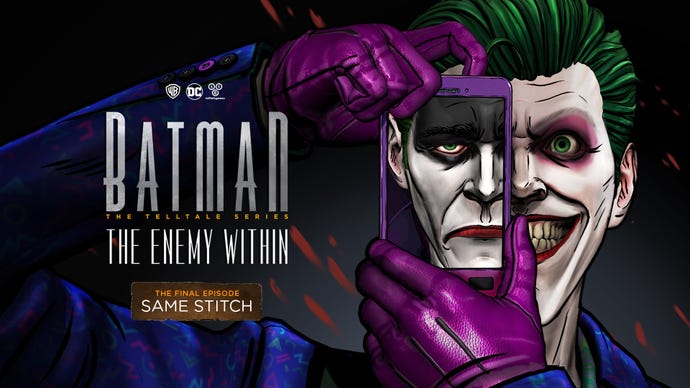How Telltale reinvented The Joker
This article contains spoilers for the final episode of Telltale’s Batman Season Two.
Before writing started on the final episode of Telltale’s Batman, there was a whiteboard in the writers’ room with notes on it. Well, there was one note on it. In large letters, circled in black board marker, sat a single word: “Joker”.
Both seasons had been building up to this - the moment where Telltale gives birth to its own version of an iconic villain, the Clown Prince of Crime.
“DC gave us a lot of freedom,” episode five lead writer Meghan Thornton tells me. “There were definitely lines we couldn’t cross, but they approved everything. We had to make a solid pitch to them and give them our reasons, but they had an open mind.”
Giving Telltale room to breathe allowed the writing team to mess with player expectations while staying true to the characters. Sure, we know Harley Quinn and Joker have a toxic, off-balance relationship, but what if the scales were tipped in Harley’s favour?
Messing with the power dynamics of these familiar relationships is what makes Telltale’s take on Batman so refreshing. In John Doe, an Arkham Asylum patient who doesn’t even know his own name, we are introduced to a Joker before he even picks up the lipstick. You are given room to mould him however you want.
“We still don’t actually know a lot about him,” Thornton explains. “He is a clean slate and Bruce’s influence builds him, which is great for a choice-based game.”
It was a delicate balance, telling the Joker’s origin story - how he actually leans into his persona - without destroying the character’s mystique, but Telltale managed it. Telltale’s Batman shows us a different side to Joker - a Joker who is quick-tempered, yet somehow vulnerable and innocent at the same time.
Everyone loves Joker the iconic villain, but Telltale’s Batman has the power to make you see him as a friend. Depending on the choices you make, the final episode gives birth to one of two Jokers: villain or vigilante.
“I grew up a Batman fan and I love Joker and, of course, I love [Mark] Hamill’s Joker,” Thornton says. “I felt very comfortable writing the villain Joker, especially given his passion for Bruce that was built throughout the season. It gave it a real source. It didn’t feel like Joker was this chaos monster.
“On the vigilante side, seeing what they did with the season before I came on, with his character, making him so appealing, and in a way really innocent, even though he did terrible things - it was really fun to explore and write a somewhat tragic tale. It was a heartbreaking thing to write and really powerful for me as a writer.”
This is a Joker that seems so close to redemption. If he becomes a villain, it is because he feels betrayed by Bruce. If he become a vigilante, it is because he is inspired by Batman. But he is still the Joker, and he does not have Bruce Wayne’s steadfast moral code. He can not be saved. That didn’t stop people from trying, however.
There are various choices throughout the season that can break Joker either way. To get him to become vigilante, you must back him up in a pivotal scene in episode four three times in a row. Three times! You have to trust this man you’ve seen do horrific things in countless incarnations three consecutive times while lives hang in the balance. So, how many people did this?
As unlikely as it may seem, Telltale’s creative communications specialist Scott Butterworth says the player split was almost 50/50, favouring Vigilante Joker. “I think people warmed to him and people wanted to see a different story than they’d seen before with Joker,” Thornton muses.
Of course, creating two different takes on the villain meant more work than ever for the narrative game studio. If you’ve ever played a season of any Telltale game twice, you will know they all end up in a similar place despite the small changes that happen along the way. One character’s death might mean the introduction of a new character who takes their place, for instance. This isn’t the case with Batman.
“From a writing standpoint, it was two completely different stories - we had two different throughlines, his character behaves totally differently,” Thornton explains. “You have a completely different experience if you play through again.”
So where does this leave the future of the series? Batman ends with one of two completely different versions of the Joker, Catwoman could be free or under the control of a quasi Suicide Squad, the Dark Knight could have a sidekick or not, and Bruce Wayne may have even hung up the cowl. With so many variables, is it even possible for Telltale to go back to the Caped Crusader?
“I think it would be possible creatively to do another season, but I can’t speak for the future of the franchise,” Thornton teases.
You can currently get the Batman Arkham and Lego games for free on the Epic Games Store.





_ddwYK80.png?width=291&height=164&fit=crop&quality=80&format=jpg&auto=webp)






